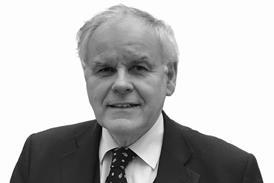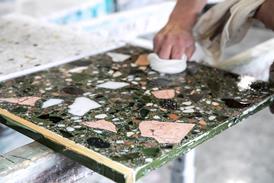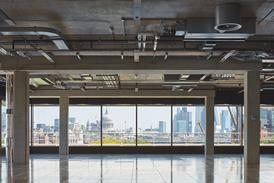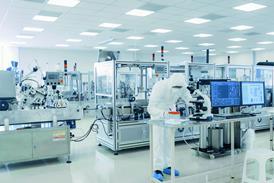An extension at one of the world’s leading scientific facilities, complete with sensitive, highly expensive equipment, left project manager Edwards Partnership with a huge procurement challenge. Steve Menary reports
Whatever project Jonathan Carkeet movesonto next year, he knows it will be will be nothing like his last job.
The ISIS Second Target Station in Didcot, Oxfordshire, represents the single largest investment in science in the UK for a quarter of a century. ‘In terms of kudos, there is no bigger project using state funding,’ says Carkeet, a director of Edwards Partnership and project manager for the job.
From the outside, the project looks like a simple extension to an existing warehouse. In fact, the structure hides some of the most high-tech machinery known to man: the ISIS station is the world’s leading centre for the production of neutrons for scientific research.
A machine called a synchrotron shoots protons down a 134m-long tunnel into a round structure called the monolith. Here, the protons hit a tungsten target and are separated into neutrons which are sent off down hatches to a series of research laboratories.
At the end of the last decade, scientists from all over the world were queuing up to use the facility. Concerned that the centre’s leading position could be threatened by clients going to the US or China, in 2003 the UK government allocated £140m to build an extension, to include a brand new synchrotron and monolith. Of the £140m, £90m was allocated to the instruments, including a costly proton beam, and the rest for the construction.
The unusual nature of the building’s highly sensitive components meant that ISIS had to find equally unusual ways of procuring the project. Instead of opting for a single lump sum contract, the complex scientific nature of the project meant that ISIS decided to break the work into packages.
The first big challenge was excavating 750,000 tonnes of chalk out of a nearby hillside for the building. VHE carried out this £1m contract during the summer of 2003 as a combination of wet weather and heavy vehicles driving over the chalk would have fatally weakened the ground. ‘Luckily 2003 was a very dry summer,’ says Carkeet.
That created a landscape akin to the a set from the James Bond film Moonraker, as another contractor, Ashe, moved in for a £3.5m design and build contract to construct a technical support building.
The shell and core of the main extension building, which was designed by architect Anshen Dyer, followed. ISIS decided to buy a 2,000-tonne steel frame in advance from Severfield Reeve then novate the firm to the main contractor. ‘We purchased this in advance as steel prices were good’, explains Carkeet. ‘Doing it this way there was a lot of time and money to be saved.’
Costain then beat Kier, Laing O’Rourke and Mowlem to the main lump sum contract, which, including VAT, was worth £27m. Costain had to carry out more demolition, including removing some asbestos, to open up the existing building for the extension. This exposed part of the existing powerful – and vastly expensive – synchrotron at the site.
‘One drop of water on the synchrotron would have meant we would have had to restart the scientific process,’ explains Carkeet. That would have been expensive and caused many problems for the scientists and companies such as Airbus and Unilever, which use the site. Costain overcame this problem by securing the entire exposed area with waterproof sheeting and mastic, and building a temporary wall.
The biggest part of the project in this period was a single 80 x 90 metre concrete slab floor, which is also 1.5 metres deep. This can withstand up to 50 tonnes per m2 and will support the huge monolith structure.
Costain successfully handed over its part of the scheme in March 2006.
When it came to the fit-out, ISIS ditched the idea of design and build and took all the design in-house, and looked for a construction manager with experience in the nuclear sector as this was closest to the skills needed at Didcot. Carkeet says: ‘We tried to take the lump sum as far as we could, but as soon as we got to anything science-related, that was the cut-off and it was clear it had to be CM.
‘We wanted traditional CM but in an engineering environment. We didn’t want to bring a traditional mentality. We are asking people to work very hard here and you can’t have a culture where people are being bollocked. If something goes wrong, we’d rather know about it and fix it instead of waiting for the machine to start up.’
we wanted traditional cm but in an engineering environment. we didn’t want to bring a traditional mentality
Jonathan Carkeet, Edwards Partnership
When the facility is brought to life, parts of machinery will not be accessed again for decades and unsealing these to rectify mistakes would be costly and time-consuming. Constant improvements in technology, which meant that the specification was to change a number of times during the build period, also made CM a logical choice.
Alstec took on the job of construction manager with ISIS using a pair of labour agencies to provide up to 45 people a week to do the work. In addition, a scaffold company was employed full-time so that access solutions were available immediately at any time. Work goes on for 22 out of 24 hours each day and the site only closes down for two days a fortnight.
ISIS brought in specialists from as far afield as Bulgaria and the US, many of which were used to working in very different areas, such as aircraft engineering. The array of specialists was needed to build the monolith at the heart of the scheme, which houses the target where the neutrons will be harvested. ‘This structure is totally unique,’ says Carkeet.
The monolith is 7.5m high and 12m in diameter.
The walls are a combination of 4m-thick steel encased in 1m of concrete. More than 5,000 tonnes of special cast steel from Corus surrounds the target to ensure it can operate safely. There is also 1,000 tonnes of steel below ground to shield ground water from possible radiation.
When CM visited the site, the monolith was nearing completion, although it was still possible to look inside to the target chamber. The first neutrons should be harvested any time and the first experiments are due in October 2008. cm
Isis Second Target Station
Total cost £140m
Build cost £50m
Client ISIS
Cost consultant/project manager Edwards Partnership Groundworks VHE,
Shell architect Anshen Dyer, Shell structural engineer WYG
Shell main contractor Costain
Shell M&E Haden Concrete cladding Scanmoor Internal fit-out construction manager Alstec
Source
Construction Manager





















No comments yet